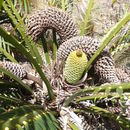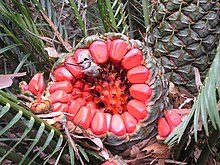ar
الأسماء في صفحات التنقل


Macrozamia communis is an Australian cycad found on the east coast of New South Wales. The common name for the species is burrawang, a word derived from the Daruk Australian Aboriginal language; this name is also often applied to other species of Macrozamia.
The burrawang has the most extensive distribution of any cycad in New South Wales and is found along the coast from the district around Armidale, New South Wales to Bega 700 km south and on the coastal slopes of the Great Dividing Range with some instances on the inland slopes of the range; as far west as the Mudgee district. It is most abundant on the south coast of the state.[2]
The plants grow in open forests.[3]

Seed cones are formed after fire. Male and female seed cones are on separate plants and the large female seeds are ripe when red or yellow.[3]
Individual specimens take 10–20 years to mature and may live for up to 120 years.[4]
Seedlings of Macrozamia communis have a tuber and coralloid roots that rise up above the ground containing cyanobacteria. These exist in a symbiotic relationship with the cycad by nitrogen fixation.[4]
The seeds of the burrawang are a good source of starch but are poisonous to eat unless treated. The Cadigal people pounded and soaked the seeds in water for a week, changing the water daily. The pulp was then made into cakes and roasted over hot embers.[5]
The conservation status of the species is "not considered to be at risk".[6]
Macrozamia communis is an Australian cycad found on the east coast of New South Wales. The common name for the species is burrawang, a word derived from the Daruk Australian Aboriginal language; this name is also often applied to other species of Macrozamia.
The burrawang has the most extensive distribution of any cycad in New South Wales and is found along the coast from the district around Armidale, New South Wales to Bega 700 km south and on the coastal slopes of the Great Dividing Range with some instances on the inland slopes of the range; as far west as the Mudgee district. It is most abundant on the south coast of the state.
The plants grow in open forests.
 Burrawang seeds, Batemans Bay, New South Wales, Australia
Burrawang seeds, Batemans Bay, New South Wales, Australia Seed cones are formed after fire. Male and female seed cones are on separate plants and the large female seeds are ripe when red or yellow.
Individual specimens take 10–20 years to mature and may live for up to 120 years.
Seedlings of Macrozamia communis have a tuber and coralloid roots that rise up above the ground containing cyanobacteria. These exist in a symbiotic relationship with the cycad by nitrogen fixation.
The seeds of the burrawang are a good source of starch but are poisonous to eat unless treated. The Cadigal people pounded and soaked the seeds in water for a week, changing the water daily. The pulp was then made into cakes and roasted over hot embers.
The conservation status of the species is "not considered to be at risk".
Macrozamia communis es una cícada de Australia encontrado en la costa este de Nueva Gales del Sur. El nombre común de la especie es burrawang, una palabra de origen aborigen australiano; el nombre también se aplica a otras especies de Macrozamia.
El burrawang tiene la más extensa distribución de cualquier cicada en Nueva Gales del Sur y se le encuentra a lo largo de la costa desde el distrito alrededor de Armidale hasta Bega 700 km al sur y en las laderas costeras de la Gran Cordillera Divisoria con algunos ejemplares en las laderas tierra adentro de la cordillera; tan al oeste como el distrito de Mudgee. Es más abundante en la costa sur del estado.[2]
Las plantas crecen en bosques abiertos.[3]
Conos de semilla se forman después de algún incendio. Conos de semilla masculinos y femeninos se forman en plantas separadas y las grandes semillas femeninas están maduras cuando están rojas o amarillas.[3]
Las semillas del burrawang son una buena fuente de almidón pero son venenosas si se comen a menos de que sean tratadas. Los aborígenes australianos molían y sumergían las semillas en agua por una semana, cambiando el agua diariamente. La pulpa era entonces preparada para hacer pasteles y también era tostada sobre brasas calientes.[4]
El estatus de conservación de la especie está "no considerada en riesgo".[5]
Macrozamia communis es una cícada de Australia encontrado en la costa este de Nueva Gales del Sur. El nombre común de la especie es burrawang, una palabra de origen aborigen australiano; el nombre también se aplica a otras especies de Macrozamia.
El burrawang tiene la más extensa distribución de cualquier cicada en Nueva Gales del Sur y se le encuentra a lo largo de la costa desde el distrito alrededor de Armidale hasta Bega 700 km al sur y en las laderas costeras de la Gran Cordillera Divisoria con algunos ejemplares en las laderas tierra adentro de la cordillera; tan al oeste como el distrito de Mudgee. Es más abundante en la costa sur del estado.
Las plantas crecen en bosques abiertos.
Conos de semilla se forman después de algún incendio. Conos de semilla masculinos y femeninos se forman en plantas separadas y las grandes semillas femeninas están maduras cuando están rojas o amarillas.
Las semillas del burrawang son una buena fuente de almidón pero son venenosas si se comen a menos de que sean tratadas. Los aborígenes australianos molían y sumergían las semillas en agua por una semana, cambiando el agua diariamente. La pulpa era entonces preparada para hacer pasteles y también era tostada sobre brasas calientes.
El estatus de conservación de la especie está "no considerada en riesgo".
Macrozamia communis L.A.S.Johnson, 1959 è una pianta appartenente alla famiglia delle Zamiaceae, endemica dell'Australia, ove è nota con il nome di burrawang.[2]
È una cicade con fusto eretto o parzialmente sotterraneo, alto sino a 1-2 m e con diametro di 30-60 cm.[3]
Le foglie, pennate, lunghe 70-200 cm, sono disposte a corona all'apice del fusto e sono rette da un picciolo lungo 12-40 cm.
È una specie dioica, con esemplari maschili che presentano da 1 a 10 strobili apicali cilindrici, lunghi 20-45 cm e larghi 8-12 cm, con microsporofilli dall'apice spinoso, ed esemplari femminili che portano da 1 a 6 coni, lunghi 20-45 cm e larghi 10-20 cm, formati da macrosporofilli armati di spine, che contengono numerosi semi grossolanamente ovoidali, lunghi 30-35 mm, ricoperti da un tegumento di colore rosso vermiglio.
L'areale di questa specie si estende lungo le aree costiere orientali del Nuovo Galles del Sud (Australia).[1]
Forma popolazioni relativamente numerose crescendo nelle foreste sclerofille costiere, su suoli sabbiosi o rocciosi, dal livello del mare sino a 300 m di altitudine.
La IUCN Red List classifica M. communis come specie a rischio minimo (Least Concern)[1].
La specie è inserita nella Appendice I della Convention on International Trade of Endangered Species (CITES)[4].
Macrozamia communis L.A.S.Johnson, 1959 è una pianta appartenente alla famiglia delle Zamiaceae, endemica dell'Australia, ove è nota con il nome di burrawang.
Рослини без надземного стовбура або деревовиді (рідко), стовбур 0-1,5 м заввишки, 40-90 см діаметром. Листків 50-150 в кроні, вони темно-зелені, напівглянсові, 140-250 см в довжину, з 70-150 листовими фрагментами; черешок 12-40 см завдовжки, прямий. Листові фрагменти прості; середні — 160-360 мм в довжину, 8-13 мм завширшки. Пилкові шишки вузькояйцевиді до веретеновиді, завдовжки 25-45 см, 8-12 см діаметром. Насіннєві шишки яйцевидні, 20-45 см, 10-20 см діаметром. Насіння плоске, яйцевиде, 30-45 мм завдовжки, 20-30 мм завширшки; саркотеста червона.
Країни поширення: Австралія (Новий Південний Уельс). Росте від рівня моря до 300 м. Рослини локально поширені в мокрих або сухих склерофітних лісах, в основному на старих пляжних пісках, й на дрібно-піщаних або кам'янистих ґрунтах на гребенях.
Міський і сільський розвиток землі вплинули на деякі підгрупи. Деякі субпопуляції є в національних парках, державних лісах.
Macrozamia communis là một loài thực vật hạt trần trong họ Zamiaceae. Loài này được L.A.S.Johnson mô tả khoa học đầu tiên năm 1959.[1]
Macrozamia communis là một loài thực vật hạt trần trong họ Zamiaceae. Loài này được L.A.S.Johnson mô tả khoa học đầu tiên năm 1959.